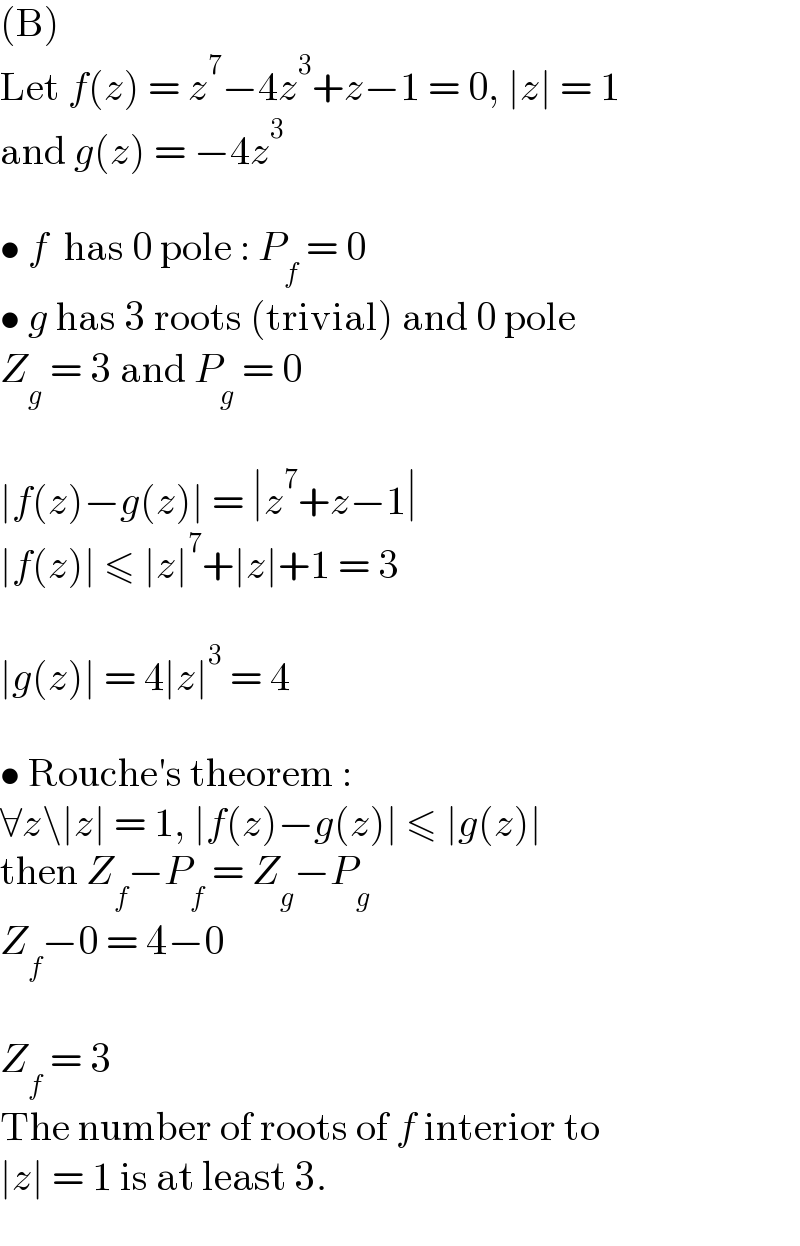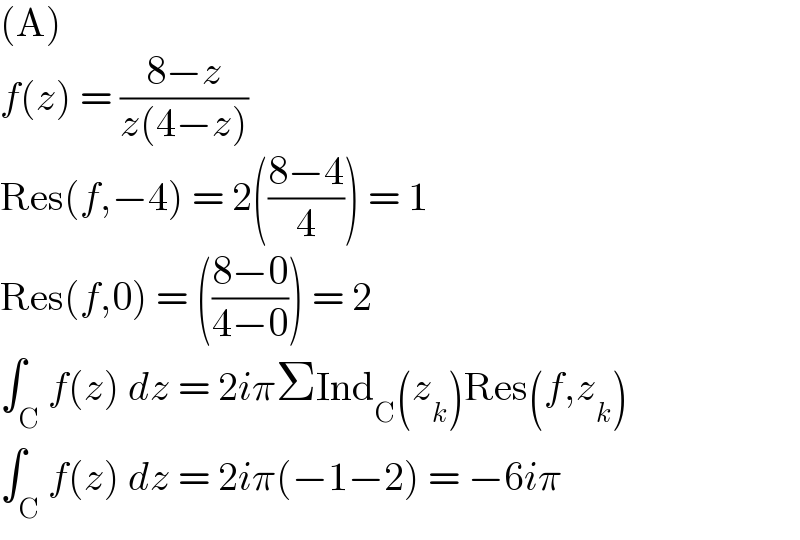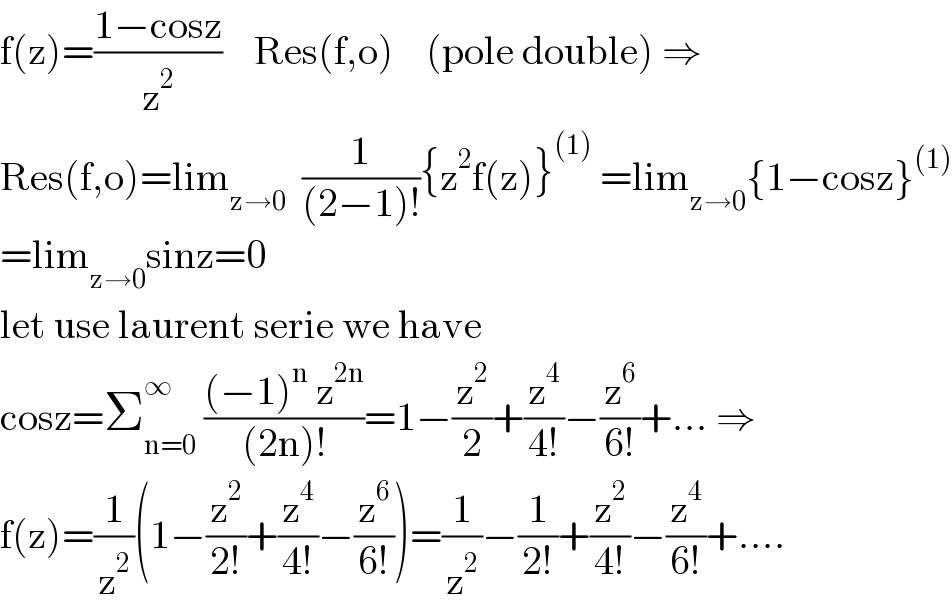
Question Number 148068 by tabata last updated on 25/Jul/21

Answered by Olaf_Thorendsen last updated on 25/Jul/21

$$\left(\mathrm{B}\right) \\ $$$$\mathrm{Let}\:{f}\left({z}\right)\:=\:{z}^{\mathrm{7}} −\mathrm{4}{z}^{\mathrm{3}} +{z}−\mathrm{1}\:=\:\mathrm{0},\:\mid{z}\mid\:=\:\mathrm{1} \\ $$$$\mathrm{and}\:{g}\left({z}\right)\:=\:−\mathrm{4}{z}^{\mathrm{3}} \\ $$$$ \\ $$$$\bullet\:{f}\:\:\mathrm{has}\:\mathrm{0}\:\mathrm{pole}\::\:{P}_{{f}} \:=\:\mathrm{0} \\ $$$$\bullet\:{g}\:\mathrm{has}\:\mathrm{3}\:\mathrm{roots}\:\left(\mathrm{trivial}\right)\:\mathrm{and}\:\mathrm{0}\:\mathrm{pole} \\ $$$${Z}_{{g}} \:=\:\mathrm{3}\:\mathrm{and}\:{P}_{{g}} \:=\:\mathrm{0} \\ $$$$ \\ $$$$\mid{f}\left({z}\right)−{g}\left({z}\right)\mid\:=\:\mid{z}^{\mathrm{7}} +{z}−\mathrm{1}\mid\: \\ $$$$\mid{f}\left({z}\right)\mid\:\leqslant\:\mid{z}\mid^{\mathrm{7}} +\mid{z}\mid+\mathrm{1}\:=\:\mathrm{3} \\ $$$$ \\ $$$$\mid{g}\left({z}\right)\mid\:=\:\mathrm{4}\mid{z}\mid^{\mathrm{3}} \:=\:\mathrm{4} \\ $$$$ \\ $$$$\bullet\:\mathrm{Rouche}'\mathrm{s}\:\mathrm{theorem}\:: \\ $$$$\forall{z}\backslash\mid{z}\mid\:=\:\mathrm{1},\:\mid{f}\left({z}\right)−{g}\left({z}\right)\mid\:\leqslant\:\mid{g}\left({z}\right)\mid \\ $$$$\mathrm{then}\:{Z}_{{f}} −{P}_{{f}} \:=\:{Z}_{{g}} −{P}_{{g}} \\ $$$${Z}_{{f}} −\mathrm{0}\:=\:\mathrm{4}−\mathrm{0} \\ $$$$ \\ $$$${Z}_{{f}} \:=\:\mathrm{3} \\ $$$$\mathrm{The}\:\mathrm{number}\:\mathrm{of}\:\mathrm{roots}\:\mathrm{of}\:{f}\:\mathrm{interior}\:\mathrm{to} \\ $$$$\mid{z}\mid\:=\:\mathrm{1}\:\mathrm{is}\:\mathrm{at}\:\mathrm{least}\:\mathrm{3}. \\ $$
Commented by tabata last updated on 25/Jul/21

$${msr}\:{pleas}\:{help}\:{me}\:{in}\:{question}\:\mathrm{148082}\:{please}\:{ajust}\:{this} \\ $$
Answered by Olaf_Thorendsen last updated on 25/Jul/21

$$\left(\mathrm{A}\right) \\ $$$${f}\left({z}\right)\:=\:\frac{\mathrm{8}−{z}}{{z}\left(\mathrm{4}−{z}\right)} \\ $$$$\mathrm{Res}\left({f},−\mathrm{4}\right)\:=\:\mathrm{2}\left(\frac{\mathrm{8}−\mathrm{4}}{\mathrm{4}}\right)\:=\:\mathrm{1} \\ $$$$\mathrm{Res}\left({f},\mathrm{0}\right)\:=\:\left(\frac{\mathrm{8}−\mathrm{0}}{\mathrm{4}−\mathrm{0}}\right)\:=\:\mathrm{2} \\ $$$$\int_{\mathrm{C}} {f}\left({z}\right)\:{dz}\:=\:\mathrm{2}{i}\pi\Sigma\mathrm{Ind}_{\mathrm{C}} \left({z}_{{k}} \right)\mathrm{Res}\left({f},{z}_{{k}} \right) \\ $$$$\int_{\mathrm{C}} {f}\left({z}\right)\:{dz}\:=\:\mathrm{2}{i}\pi\left(−\mathrm{1}−\mathrm{2}\right)\:=\:−\mathrm{6}{i}\pi \\ $$
Answered by mathmax by abdo last updated on 26/Jul/21

$$\mathrm{f}\left(\mathrm{z}\right)=\frac{\mathrm{1}−\mathrm{cosz}}{\mathrm{z}^{\mathrm{2}} }\:\:\:\:\mathrm{Res}\left(\mathrm{f},\mathrm{o}\right)\:\:\:\:\left(\mathrm{pole}\:\mathrm{double}\right)\:\Rightarrow \\ $$$$\mathrm{Res}\left(\mathrm{f},\mathrm{o}\right)=\mathrm{lim}_{\mathrm{z}\rightarrow\mathrm{0}} \:\:\frac{\mathrm{1}}{\left(\mathrm{2}−\mathrm{1}\right)!}\left\{\mathrm{z}^{\mathrm{2}} \mathrm{f}\left(\mathrm{z}\right)\right\}^{\left(\mathrm{1}\right)} \:=\mathrm{lim}_{\mathrm{z}\rightarrow\mathrm{0}} \left\{\mathrm{1}−\mathrm{cosz}\right\}^{\left(\mathrm{1}\right)} \\ $$$$=\mathrm{lim}_{\mathrm{z}\rightarrow\mathrm{0}} \mathrm{sinz}=\mathrm{0} \\ $$$$\mathrm{let}\:\mathrm{use}\:\mathrm{laurent}\:\mathrm{serie}\:\mathrm{we}\:\mathrm{have} \\ $$$$\mathrm{cosz}=\sum_{\mathrm{n}=\mathrm{0}} ^{\infty} \:\frac{\left(−\mathrm{1}\right)^{\mathrm{n}} \:\mathrm{z}^{\mathrm{2n}} }{\left(\mathrm{2n}\right)!}=\mathrm{1}−\frac{\mathrm{z}^{\mathrm{2}} }{\mathrm{2}}+\frac{\mathrm{z}^{\mathrm{4}} }{\mathrm{4}!}−\frac{\mathrm{z}^{\mathrm{6}} }{\mathrm{6}!}+...\:\Rightarrow \\ $$$$\mathrm{f}\left(\mathrm{z}\right)=\frac{\mathrm{1}}{\mathrm{z}^{\mathrm{2}} }\left(\mathrm{1}−\frac{\mathrm{z}^{\mathrm{2}} }{\mathrm{2}!}+\frac{\mathrm{z}^{\mathrm{4}} }{\mathrm{4}!}−\frac{\mathrm{z}^{\mathrm{6}} }{\mathrm{6}!}\right)=\frac{\mathrm{1}}{\mathrm{z}^{\mathrm{2}} }−\frac{\mathrm{1}}{\mathrm{2}!}+\frac{\mathrm{z}^{\mathrm{2}} }{\mathrm{4}!}−\frac{\mathrm{z}^{\mathrm{4}} }{\mathrm{6}!}+.... \\ $$
Commented by mathmax by abdo last updated on 26/Jul/21

$$\mathrm{Res}\left(\mathrm{f},\mathrm{o}\right)=\mathrm{coefficient}\:\mathrm{de}\:\frac{\mathrm{1}}{\mathrm{z}}\:=\mathrm{0} \\ $$
